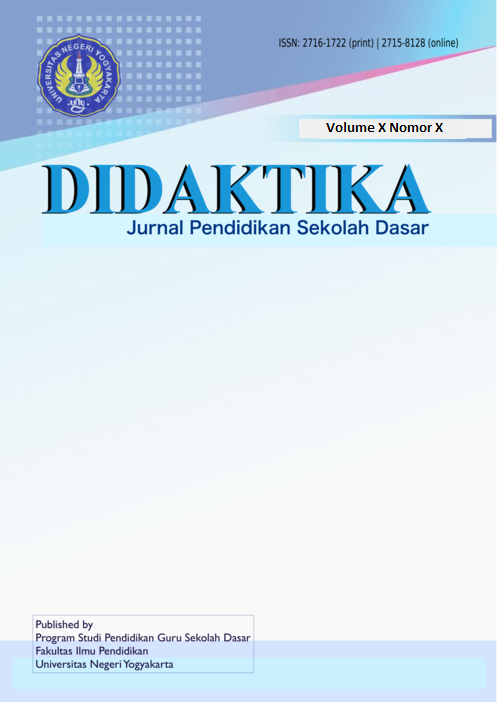Upaya Meningkatkan Kemampuan Pemecahan Masalah Matematika dengan Menggunakan Model Problem Solving di Sekolah Dasar
DOI:
https://doi.org/10.21831/didaktika.v2i1.28092Abstract
This research is motivated by the low ability to solve mathematical problems in fifth grade students of SDN Kaliabang Tengah 1 Bekasi Utara. Seen when researchers provide exercises in the description of mathematical problems in the form of stories on fraction material. There is still a lack of student knowledge regarding fractional material. When working on the story problem students simply add up or subtract the denominator by the denominator and the numerator by the numerator, without first equating the denominator. Students have not been able to solve problems correctly and many are still wrong. The lack of students' ability to infer results obtained from mathematical story problems. Enthusiastic students are lacking in solving mathematical story problems that are considered difficult. This study aims to improve the ability to solve mathematical problems using problem solving models in fifth grade students at SDN Kaliabang Tengah 1, North Bekasi. The research method uses Classroom Action Research (CAR) which consists of 3 cycles.. The conclusion of this study is the problem solving model can improve the ability to solve mathematical problems in fifth grade students at SDN Kaliabang Tengah 1 Bekasi Utara.
References
Arikunto, S,. dkk. (2015) Penelitian Tindakan Kelas. Jakarta. PT Bumi Aksara
Bernard, M., dkk. (2018). Analisis Kemampuan Pemecahan Masalah Matematis Siswa SMP Kelas IX Pada Materi Bangun Datar. SJME (Supremum Journal of Mathematics Education), Vol. 2, No. 1, July 2018, hlm 77-83. (http:///journal.unsika.ac.id/index.php/supremum). (diakses pada tanggal 25 September 2018, pukul 22.18)
Darmadi, H. (2014). Metode Penelitian Pendidikan dan Sosial. Bandung. Alfabeta
Hadi, S., & Radiyatul. (2014). Metode Pemecahan Masalah Menurut Polya Untuk Mengembangkan Kemampuan Siswa dalam Pemecahan Masalah Matematis Di Sekolah Menengah Pertama. EDU-Mat Jurnal Pendidikan Matematika, Vol. 2, No. 1, Februari 2014, hlm 53-61. (https:///download.portalgaruda.org). (diakses tanggal 5 Juli 2018, pukul 21.48)
Istiqoma, F., & Rusdi, A. (2015). Pengaruh Penerapan Metode Problem Solving Pada Mata Pelajaran Matematika Materi Pecahan Terhadap Hasil Belajar Siswa Kelas III Di Madrasah Ibtidaiyah Muhajirin Palembang. Vol. 5, Juli 2015. (https:///download.portugalgaruda.org). (diakses pada tanggal 25 Agustus2018, pukul 07.52)
Juliani, A., & Norlaila. (2014). Kemampuan Pemecahan Masalah Matematika Siswa Dalam Pembelajaran Matematika Menggunakan Model Cooperative Script. EDU-MAT Jurnal Pendidikan Matematika, Vol.2, No.3, Oktober 2014, hlm 250-259. (https://download.portugalgaruda.org). (diakses pada tanggal 5 Juli 2018, pukul 16.18)
Netriwati. (2016). Analisis Kemampuan Mahasiswa dalam Pemecahkan Masalah Matematis menurut Teori Polya. Al-Jabar : Jurnal Pendidikan Matematika, Vol. 7, No. 2, 2016, hal 181-190. (diakses pada tanggal 4 September 2018, pukul 14.52)
Shoimin, A. (2014). 68 Model Pembelajaran Inovatif dalam Kurikulum 2013. Yogyakarta. Ar-Ruzz Media
Sugiyono. (2015). Metode Penelitian Pendidikan Pendekatan Kuantitatif, Kualitataif dan R&D. Bandung. Alfabeta
Susanto, A. (2013). Teori Belajar dan Pembelajaran di Sekolah Dasar. Jakarta.Prenadamedia Group
Tampubolon, S. (2014). Penelitian Tindakan Kelas Sebagai Pengembangan Profesi Pendidikan dan Keilmuan. Erlangga
Downloads
Published
How to Cite
Issue
Section
Citation Check
License
- Authors retain copyright and grant the journal right of first publication with the work simultaneously licensed under a Creative Commons Attribution License that allows others to share the work with an acknowledgement of the work's authorship and initial publication in this journal.
- Authors are able to enter into separate, additional contractual arrangements for the non-exclusive distribution of the journal's published version of the work (e.g., post it to an institutional repository or publish it in a book), with an acknowledgement of its initial publication in this journal.
- Authors are permitted and encouraged to post their work online (e.g., in institutional repositories or on their website) prior to and during the submission process, as it can lead to productive exchanges, as well as earlier and greater citation of published work.






